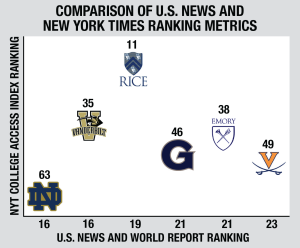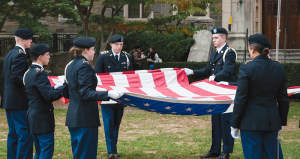
Georgetown fell out of U.S. News and World Report’s annual top 20 university rankings, released Tuesday, and was also named the best university for veterans. Georgetown also placed 46th among the 90 schools ranked in The New York Times’ first ever socioeconomic college-ranking poll, released Monday.
U.S. News and World Report
The popular U.S. News and World Report National University ranking placed Georgetown at 21, tied with Emory University, one place lower than last year’s ranking of 20, also tied with Emory. Dean of Undergraduate Admissions Charles Deacon said he was unconcerned.
“Whatever tiny decimal point might have separated [the 20th school] out, we’re essentially all in the same place as we were before and I don’t think it has any significant difference,” he said.
University Director of Media Relations Rachel Pugh agreed, adding that she did not anticipate any change in donations to Georgetown now that the university is no longer in the top 20.
“I am not aware of this being an issue. We are pleased to be recognized with strong ratings across all categories,” she wrote in an email.
Georgetown has never fallen below 23 or risen above 17 in the U.S. News rankings.
“You shouldn’t really change very much at all, unless they change the metrics,” Deacon said. “And unless they reduce the impact of dollars, of endowment per student, faculty endowment in the ranking, we’re never going to rank much higher than 20, unless we suddenly raise lots and lots of money.”

Number One for Veterans
Georgetown’s U.S. News top rank among the Best National Universities for Veterans comes after a comprehensive university push to increase resources for veterans.
To qualify to be ranked, the university must be certified by the G.I. Bill and registered with the Yellow Ribbon Program.
Jack Schumacher (MSB ’15), a veteran who served six years in the army deployed in Iraq and Afghanistan, praised Georgetown for participating in the Yellow Ribbon Program, which gives veterans more financial support in addition to the Post-9/11 G.I. Bill grant, and for providing veterans with speakers and networking opportunities.
“Being able to link up with former veterans who are either Georgetown graduates or just want to give back to the Georgetown community is a big help, for them to give us personal guidance coming to the university and helping us network and kind of branch out with our veteran experience,” Schumacher said.
He also hailed Washington, D.C., as somewhat of a haven for veterans.
“If you throw a stone at someone in the D.C. area, you’re going to hit another veteran,” he said. “So it’s a great area where we hold our heads high, talk to other people who’ve had similar experiences and also share that with the general student body who are extremely welcoming, and I hope for the future, that the veterans community at Georgetown only grows.”
Last year, the first year that the U.S. News released a ranking for veterans, Georgetown did not even place in the top five. University President John J. DeGioia honored Georgetown’s veterans in a Facebook post sharing the news.
“All Hoyas should be proud that Georgetown University has been named the #1 Best College for Veterans by the U.S. News and World Report! Reporting an engaging educational experience for our veterans enriches our community,” he wrote.
New York Times Rankings
Released by the Upshot, a data-driven blog focused on politics, policy and economics, The New York Times rankings, also known as the College Access Index, were based on the percentage of students receiving Federal Pell Grants and the average net cost per year for students from families making between $30,000 and $48,000 per year.
A school at the mean in both measures would receive a score of zero. Out of schools with a four-year graduation rate of at least 75 percent, Georgetown received a score of 0.2 standard deviations above the mean, along with five other schools, including Bowdoin College, Bryn Mawr College, Wofford College, the University of Richmond and Yale University.
David Leonhardt, managing editor of The Upshot, wrote in an accompanying article that the college access index measures efforts by colleges to attract poor and middle-class students.
Deacon identified several factors contributing to Georgetown’s average ranking, such as Georgetown’s smaller endowment, despite a push to attract low-income students.
“They’re trying to take data and make it support a point of view. And it’s data that’s apples and oranges,” Deacon said.”My reaction is, we were tied with Yale and they have a $2 million endowment per student and we have $80,000, so they could’ve done better than we did, but they obviously haven’t.”
Deacon also criticized the rankings for not including graduation rates for low-income students in the analysis, as the Georgetown Scholarship Program, Georgetown’s program for low-income students, flaunts a 97 percent graduation rate.
Georgetown’s $80,000 endowment per student is the smallest among the schools with which it tied, and was less than or equal to every school ranked above it, with the exception of Susquehanna University. The rankings included the institutions’ endowment per student as a reference, but endowment did not figure into the calculation of the rankings.
Additionally, Georgetown was ranked highest of all of the Catholic schools on the list.
Nora Gordon, a professor at the McCourt School of Public Policy, stressed that the Times’ rankings failed to factor in selectivity, capturing too many schools under the umbrella of “top colleges.”
“It would be interesting to see their access index side by side with how selective the colleges are. Among colleges with a graduation rate of at least 75 percent, there is a lot of variation in selectivity,” Gordon said.
Regardless of Georgetown’s place in the rankings, Deacon said that for an institution of Georgetown’s endowment and selectivity, it is performing well on economic diversity.
“We are definitely moving in the right direction, there’s no question. Within our capacity to afford what we’re doing, I think that extremely successful graduation rate and programs like the GSP and Community Scholars and others are really making sure that those kids who do get here get a really great experience and come out the other end with opportunities,” Deacon said.”I don’t worry so much, just like I don’t worry about U.S. News rankings. I don’t think that ranking is going to make much difference in our situation.”
GSP Director Missy Foy said that with peer support, alumni connections and professional guidance for low-income students, the program offers a quality of experience for low-income students. Despite Georgetown’s average ranking, she added that she was appreciative that the rankings drew greater attention to progress in diversity.
“There is so much doom and gloom about low-income students ever making it to college or first [generation students] ever making it to college; it seems like the press focuses on that news. So I was pleasantly surprised to see an article that actually recognized schools that were making progress in this area too,” she said. “There is still a lot more to be done. There’s certainly room for improvement and the university hopes for that.”
Queen Adesuyi (COL ’16), a GSP student, was surprised to hear of Georgetown’s mediocre NYT ranking.
“I was kind of surprised because GSP has been expanding and the strength of the program made me feel like we were different in so many ways,” she said. “The survey doesn’t reflect that, unfortunately.”
Suzanne Monyak contributed reporting.














